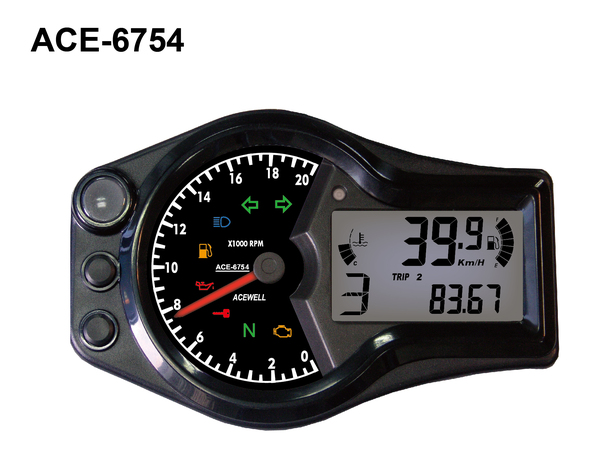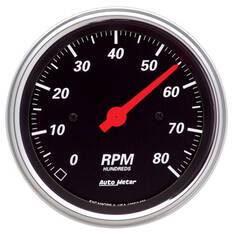Specialist Tips for Keeping and Adjusting Your Tachometer
Specialist Tips for Keeping and Adjusting Your Tachometer
Blog Article
The Significance of a Tachometer in Keeping An Eye On Engine Speed and Efficiency in Automotive Applications
In the realm of vehicle engineering, the tachometer stands as an essential instrument in the motorist's arsenal, supplying a direct window right into the inner operations of a vehicle's engine. Past its feature as a simple scale of revolutions per min (RPM), the tachometer serves as a crucial device for enthusiasts and experts alike, supplying real-time understandings right into engine performance and health. Recognizing the importance of this gadget exceeds surface-level observations, diving into the intricate connection in between engine speed, power outcome, and general driving experience. As we explore the diverse function of the tachometer in auto applications, a deeper gratitude for its influence on lorry dynamics and efficiency begins to emerge.
Relevance of Monitoring Engine RPM
Monitoring engine RPM, or revolutions per min, is a critical aspect of automotive upkeep and efficiency analysis. Engine RPM straight correlates with the speed at which the engine's crankshaft rotates, indicating how rapidly the engine is running - tachometer. By keeping track of RPM, mechanics can evaluate the health of the engine, spot potential issues, and fine-tune efficiency. An irregular RPM reading may signify issues such as engine misfires, defective ignition system, or concerns with the gas shipment system. Consistently high RPM analyses might suggest aggressive driving behaviors or the requirement for a higher equipment change to improve gas effectiveness.
Moreover, monitoring engine RPM is vital for efficiency evaluation in racing and high-performance automobiles. In summary, keeping track of engine RPM is not just crucial for detecting concerns but likewise for enhancing engine performance in numerous automotive applications.

Benefits of Real-Time Information
In auto applications, real-time data plays an essential duty in supplying immediate insights right into the performance and problem of the lorry. By continually monitoring various parameters such as engine speed, temperature, fuel consumption, and more, real-time data supplies numerous advantages that add to boosted performance and safety and security on the roadway.
One substantial advantage of real-time information is its capacity to sharp motorists and service technicians to any type of anomalies or issues promptly. This proactive strategy makes it possible for fast identification of potential troubles, permitting for prompt interventions to avoid further damages or malfunctions. Furthermore, real-time data facilitates efficiency optimization by supplying instant feedback on driving behaviors and engine effectiveness. Chauffeurs can adjust their actions in real-time based upon this information to attain far better fuel economy and extend the lifespan of their vehicle.

In addition, real-time data plays an essential role in modern-day automotive diagnostics, allowing technicians to swiftly diagnose and deal with breakdowns. This leads to minimized downtime, reduced maintenance expenses, and inevitably, improved general lorry reliability and long life (tachometer). By utilizing the power of real-time information, automotive stakeholders can make educated choices that positively affect both the efficiency and long life of the vehicle
Influence on Equipment Shifts
Efficient gear shifts in vehicle applications considerably influence general efficiency and driving experience. The tachometer plays a crucial function in enhancing equipment changes by providing real-time engine speed information to the vehicle driver. When approaching the redline on the tachometer, it signals the chauffeur to upshift to stop over-revving the engine and creating possible damage. On the other hand, downshifting at the appropriate moment can help preserve the engine in its power band, making certain responsive acceleration when needed.
Moreover, the tachometer help in attaining smoother equipment transitions, particularly in manual transmissions. By monitoring engine rate, motorists can carry out gear Going Here shifts at the optimum RPM variety, minimizing jerking motions and decreasing endure the transmission components. This precision on duty modifications not find out this here only boosts driving convenience but also adds to fuel efficiency.
Enhancing Gas Effectiveness
Given the essential function the tachometer plays in optimizing equipment changes for performance and engine health, it directly contributes to optimizing fuel effectiveness in vehicle applications. By supplying real-time comments on engine rate, the tachometer aids motorists in maintaining one of the most effective RPM array for fuel economic situation. When motorists consistently check the tachometer and adjust their motoring practices as necessary, they can avoid unneeded fuel usage brought on by over-revving or carrying the engine.
Moreover, the tachometer assists vehicle drivers determine one of the most fuel-efficient gear to be in at any type of provided moment, protecting against the engine from working more challenging than necessary. This is especially crucial during velocity and cruising, where being in the appropriate gear can substantially impact fuel effectiveness. In addition, the tachometer can alert chauffeurs to possible mechanical issues that might be adversely influencing fuel economic climate, such as a sliding clutch or a clogged up air filter. To conclude, the tachometer acts as a valuable tool in improving gas performance by promoting optimal driving practices and determining locations for renovation in the vehicle's performance.

Taking Full Advantage Of Engine Durability
The tachometer's function in keeping an eye on engine speed and performance is instrumental in ensuring the longevity of automotive engines. By making use of the tachometer successfully, motorists can enhance engine longevity through conscious RPM administration. Regularly revving an engine too expensive can lead to too much deterioration on crucial components, important source such as the pistons, shutoffs, and bearings. Gradually, this can lead to decreased engine efficiency and possible malfunctions. Monitoring the tachometer permits motorists to stay within the recommended RPM variety for their lorry, stopping unnecessary strain on the engine and extending its lifespan.

Conclusion
Finally, the tachometer plays a vital function in monitoring engine speed and performance in automotive applications. By offering real-time information on RPM, it permits reliable gear changes, improved fuel effectiveness, and optimized engine longevity. This device is vital for preserving ideal engine efficiency and making sure the overall performance of a vehicle.
Report this page